Showing Spotlights 2065 - 2072 of 2782 in category All (newest first):
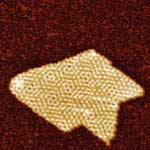 DNA, the fundamental building block of life, has become an intense nanotechnology research field. DNA molecules can serve as precisely controllable and programmable scaffolds for organizing functional nanomaterials in the design, fabrication, and characterization of nanoscale devices such as sensors and electronics. Most DNA research on controlled self-assembly deals with two-dimensional, i.e. flat, patterns and an expansion of these arrays into the third dimension has been challenging. New research coming out of UC Santa Barbara describes the self-assembly of multilayer hexagonal DNA arrays through highly regular interlayer packing. The researchers found that DNA arrays assembled into a two dimensional hexagonal pattern, or a sheet, assemble further into multilayer stacks.
DNA, the fundamental building block of life, has become an intense nanotechnology research field. DNA molecules can serve as precisely controllable and programmable scaffolds for organizing functional nanomaterials in the design, fabrication, and characterization of nanoscale devices such as sensors and electronics. Most DNA research on controlled self-assembly deals with two-dimensional, i.e. flat, patterns and an expansion of these arrays into the third dimension has been challenging. New research coming out of UC Santa Barbara describes the self-assembly of multilayer hexagonal DNA arrays through highly regular interlayer packing. The researchers found that DNA arrays assembled into a two dimensional hexagonal pattern, or a sheet, assemble further into multilayer stacks.
Jan 29th, 2009
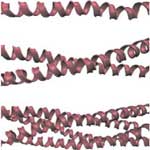 In a previous Nanotechnology Spotlight, we describe how, in order to develop tomorrow's supermaterials, scientists need to unlock nature's structural design rules, in particular for nanoscopic hierarchical molecular structures, and make them available to engineers. This is only possible through a deep understanding of the structure-property relations in biological materials. There is also a surprising relationship between these material design issues and the understanding (or rather lack thereof) of genetic diseases, where structural changes are due to mutations on the molecular level that lead to changed chemical and mechanical properties, which in turn lead to a malfunction of the protein network under mechanical load. Hierarchical nanostructures - ranging through atomistic, molecular and macroscopic scales - represent universal features of biological protein materials. New work by MIT professor Markus Buehler discusses the role of these structural hierarchies in determining properties of biological materials.
In a previous Nanotechnology Spotlight, we describe how, in order to develop tomorrow's supermaterials, scientists need to unlock nature's structural design rules, in particular for nanoscopic hierarchical molecular structures, and make them available to engineers. This is only possible through a deep understanding of the structure-property relations in biological materials. There is also a surprising relationship between these material design issues and the understanding (or rather lack thereof) of genetic diseases, where structural changes are due to mutations on the molecular level that lead to changed chemical and mechanical properties, which in turn lead to a malfunction of the protein network under mechanical load. Hierarchical nanostructures - ranging through atomistic, molecular and macroscopic scales - represent universal features of biological protein materials. New work by MIT professor Markus Buehler discusses the role of these structural hierarchies in determining properties of biological materials.
Jan 27th, 2009
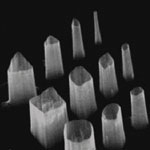 Among the many challenges that researchers have to overcome in developing bottom-up nanotechnology fabrication techniques and processes, the requirement for extremely precise, nanometer-scale control of positioning and shaping of objects is one of the most vexing. New work by a team of scientists in Korea demonstrates the position- and shape-controlled growth of nanoarchitectures using the selective growth of nanowalls with conventional lithography and catalyst-free metal organic vapor-phase epitaxy (MOVPE). This presents a significant advance towards the fabrication of artificial 1D and 2D nanomaterials as functional components in many integrated electronic and photonic devices.
Among the many challenges that researchers have to overcome in developing bottom-up nanotechnology fabrication techniques and processes, the requirement for extremely precise, nanometer-scale control of positioning and shaping of objects is one of the most vexing. New work by a team of scientists in Korea demonstrates the position- and shape-controlled growth of nanoarchitectures using the selective growth of nanowalls with conventional lithography and catalyst-free metal organic vapor-phase epitaxy (MOVPE). This presents a significant advance towards the fabrication of artificial 1D and 2D nanomaterials as functional components in many integrated electronic and photonic devices.
Jan 26th, 2009
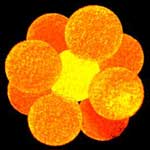 Colloidal materials have been playing a major role in many research fields such as chemistry, materials science, condensed matter physics, applied optics, fluid dynamics, and biology. Most of these studies require the use of monodisperse colloidal particles with uniformity in shape, size, composition, structure and surface properties. Both our current understanding of various physical phenomena and our capability to fabricate new functional materials have been considerably enriched by the development of synthetic strategies that are capable of generating copious quantities of colloidal entities of good size uniformity. Nevertheless, most of the available monodisperse colloidal materials are spherical because this represents a thermodynamically favorable state in terms of surface energy. This strongly limits the number of new structures which can be engineered by using these colloids as building blocks. A novel synthetic route can now produce a full set of new non-spherical, binary colloids with regular morphology in a high yield.
Colloidal materials have been playing a major role in many research fields such as chemistry, materials science, condensed matter physics, applied optics, fluid dynamics, and biology. Most of these studies require the use of monodisperse colloidal particles with uniformity in shape, size, composition, structure and surface properties. Both our current understanding of various physical phenomena and our capability to fabricate new functional materials have been considerably enriched by the development of synthetic strategies that are capable of generating copious quantities of colloidal entities of good size uniformity. Nevertheless, most of the available monodisperse colloidal materials are spherical because this represents a thermodynamically favorable state in terms of surface energy. This strongly limits the number of new structures which can be engineered by using these colloids as building blocks. A novel synthetic route can now produce a full set of new non-spherical, binary colloids with regular morphology in a high yield.
Jan 23rd, 2009
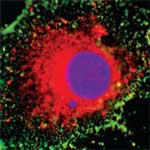 One of the major concerns regarding the potential risks of nanotechnology applications are possible toxic effects of nanoparticles. The concern is that these materials have the capacity to penetrate cells and potentially translocate to other cells, tissues and organs remote from the portal of entry to the body. This is considered to be a necessary step in the movement of particles deposited in the lung, entering the blood, acting upon cells in other tissues, manifesting ultimately in a physiological response. The importance of translocation in nanoparticle toxicology has been the subject of a recently completed nanotoxicology research project called 'Cell Pen', conducted by the Institute of Occupational Medicine in the UK together with a team of multi-disciplinary experts. As with so many previous nanotechnology risk review reports, it appears that this documents highlight more the uncertainties and the unknown than what is actually known about the interaction of nanoparticles with cells.
One of the major concerns regarding the potential risks of nanotechnology applications are possible toxic effects of nanoparticles. The concern is that these materials have the capacity to penetrate cells and potentially translocate to other cells, tissues and organs remote from the portal of entry to the body. This is considered to be a necessary step in the movement of particles deposited in the lung, entering the blood, acting upon cells in other tissues, manifesting ultimately in a physiological response. The importance of translocation in nanoparticle toxicology has been the subject of a recently completed nanotoxicology research project called 'Cell Pen', conducted by the Institute of Occupational Medicine in the UK together with a team of multi-disciplinary experts. As with so many previous nanotechnology risk review reports, it appears that this documents highlight more the uncertainties and the unknown than what is actually known about the interaction of nanoparticles with cells.
Jan 22nd, 2009
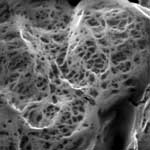 Collagen is one of the most essential and plentiful proteins in humans, making up about one quarter of all proteins in the body. It is also a major component of connective tissue such as cartilage, ligaments, tendons, bone and skin. Due to its excellent biocompatibility, biodegradability, and the ease of extraction, purification, and processing, collagen has found use as a versatile biomaterial in numerous medical applications. However, collagen is susceptible to biodegradation and the mechanical stability of native collagen for use in tissue repair is insufficient. In order to slow down the biodegradation rate, researchers have developed numerous chemical cross-linking techniques where individual protein chains are linked with a covalent bond, thereby stabilizing the protein. Scientists have now proposed a novel approach to collagen cross-linking on the basis of gold nanoparticles, opening a path to using collagen as a medium for delivery of drug molecules.
Collagen is one of the most essential and plentiful proteins in humans, making up about one quarter of all proteins in the body. It is also a major component of connective tissue such as cartilage, ligaments, tendons, bone and skin. Due to its excellent biocompatibility, biodegradability, and the ease of extraction, purification, and processing, collagen has found use as a versatile biomaterial in numerous medical applications. However, collagen is susceptible to biodegradation and the mechanical stability of native collagen for use in tissue repair is insufficient. In order to slow down the biodegradation rate, researchers have developed numerous chemical cross-linking techniques where individual protein chains are linked with a covalent bond, thereby stabilizing the protein. Scientists have now proposed a novel approach to collagen cross-linking on the basis of gold nanoparticles, opening a path to using collagen as a medium for delivery of drug molecules.
Jan 21st, 2009
 In case you want to get up to date on what's happening around the world with regard to the development of risk governance for nanotechnology applications in food and cosmetics, a new report just out from the International Risk Governance Council (IRGC) provides a good overview. An early version of this report was originally written as a briefing paper for an expert workshop organized by the IRGC in 2008. It is also a companion to the IRGC Policy Brief due for publication in early 2009. While this report does not include any primary research, is is a useful primer for anyone who wants to get an overview of what is happening in this area. IRGC is an independent organisation whose purpose is to help the understanding and management of global risks that impact on human health and safety, the environment, the economy and society at large. The organization's focus on risk governance strategies for nanotechnology applications in food and cosmetics is based on rising public concerns.
In case you want to get up to date on what's happening around the world with regard to the development of risk governance for nanotechnology applications in food and cosmetics, a new report just out from the International Risk Governance Council (IRGC) provides a good overview. An early version of this report was originally written as a briefing paper for an expert workshop organized by the IRGC in 2008. It is also a companion to the IRGC Policy Brief due for publication in early 2009. While this report does not include any primary research, is is a useful primer for anyone who wants to get an overview of what is happening in this area. IRGC is an independent organisation whose purpose is to help the understanding and management of global risks that impact on human health and safety, the environment, the economy and society at large. The organization's focus on risk governance strategies for nanotechnology applications in food and cosmetics is based on rising public concerns.
Jan 20th, 2009
 Typically, nanoparticles have been used for drug delivery and it has been only recently that carbon nanotubes (CNTs) have gained attention as potential drug delivery vehicles. Carbon nanotubes offer a number of advantages which suggest that they may provide an improved result over nanoparticles. They have a larger inner volume which allows more drug molecules to be encapsulated, and this volume is more easily accessible because the end caps can be easily removed, and they have distinct inner and outer surfaces for functionalization. Current research has shown the ability of CNTs to carry a variety of molecules such as drugs, DNA, proteins, peptides, targeting ligands etc. into cells - which makes them suitable candidates for targeted delivery applications. Despite these advantages, a suitable delivery system has not been developed yet for the targeted delivery of CNTs to specific sites.
A research team from various Canadian and U.S. universities has now demonstrated, for the first time, the design and development of a novel microcapsule carbon nanotube targeted delivery device.
Typically, nanoparticles have been used for drug delivery and it has been only recently that carbon nanotubes (CNTs) have gained attention as potential drug delivery vehicles. Carbon nanotubes offer a number of advantages which suggest that they may provide an improved result over nanoparticles. They have a larger inner volume which allows more drug molecules to be encapsulated, and this volume is more easily accessible because the end caps can be easily removed, and they have distinct inner and outer surfaces for functionalization. Current research has shown the ability of CNTs to carry a variety of molecules such as drugs, DNA, proteins, peptides, targeting ligands etc. into cells - which makes them suitable candidates for targeted delivery applications. Despite these advantages, a suitable delivery system has not been developed yet for the targeted delivery of CNTs to specific sites.
A research team from various Canadian and U.S. universities has now demonstrated, for the first time, the design and development of a novel microcapsule carbon nanotube targeted delivery device.
Jan 19th, 2009
 DNA, the fundamental building block of life, has become an intense nanotechnology research field. DNA molecules can serve as precisely controllable and programmable scaffolds for organizing functional nanomaterials in the design, fabrication, and characterization of nanoscale devices such as sensors and electronics. Most DNA research on controlled self-assembly deals with two-dimensional, i.e. flat, patterns and an expansion of these arrays into the third dimension has been challenging. New research coming out of UC Santa Barbara describes the self-assembly of multilayer hexagonal DNA arrays through highly regular interlayer packing. The researchers found that DNA arrays assembled into a two dimensional hexagonal pattern, or a sheet, assemble further into multilayer stacks.
DNA, the fundamental building block of life, has become an intense nanotechnology research field. DNA molecules can serve as precisely controllable and programmable scaffolds for organizing functional nanomaterials in the design, fabrication, and characterization of nanoscale devices such as sensors and electronics. Most DNA research on controlled self-assembly deals with two-dimensional, i.e. flat, patterns and an expansion of these arrays into the third dimension has been challenging. New research coming out of UC Santa Barbara describes the self-assembly of multilayer hexagonal DNA arrays through highly regular interlayer packing. The researchers found that DNA arrays assembled into a two dimensional hexagonal pattern, or a sheet, assemble further into multilayer stacks.
 Subscribe to our Nanotechnology Spotlight feed
Subscribe to our Nanotechnology Spotlight feed





